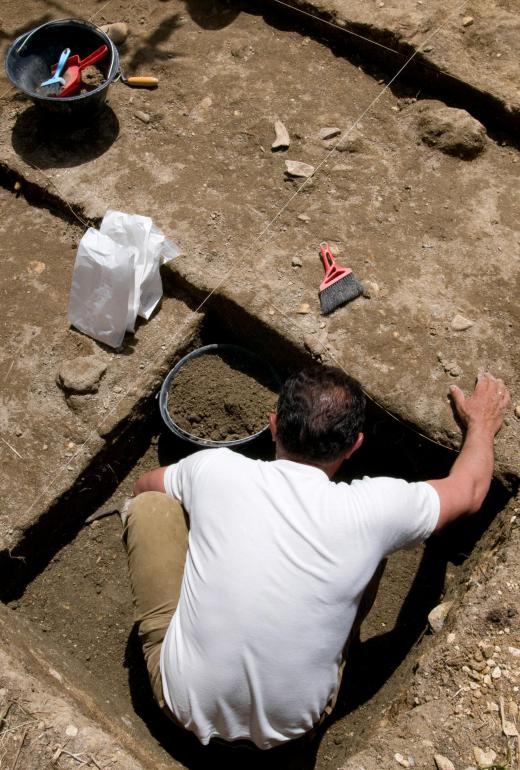What Are the Different Types of Archaeological Theory?
Most archaeological theories deal with many of the same techniques, evidence, and historical facts, but approach them differently. Ancient civilizations were just as complex and rich as the civilizations that exist today, meaning there are dozens of different ways to approach and study them. Archaeological theory has always been a matter of controversy, slipping from cultural history to processual and behavioral archaeology. These methods eventually led to an archaeological theory called post-processual archaeology.
Experts in the field of archaeology have almost always argued over which archaeological theory is the most important and most streamlined. Cultural historical archaeology developed in around 1860, after Darwin’s theories of evolution and natural selection became very popular. Proponents of cultural historical archaeology theorized that every culture is distinct and separate, with very rigid codes of normal behavior. For instance, if two pieces of pottery were found at a dig site, with one bearing stippled patterns and the other decorated with stripes, a cultural historical archaeologist would assume that the two pieces came from two separate cultures.

The methods of cultural history theory were found to be somewhat flawed, though not illogical. This method of archaeology posited that all changes and variations within a culture had to be derived from that people’s observation of another culture. The focus was mainly on why cultures changed and developed, rather than just noting that these developments happened. Methods for determining trade, movement, and cross-culture relations were retained from cultural historical archaeology and applied to other archaeological theories.

Processual archaeological theory developed both within, and steered away from, cultural historical archaeology. Beginning in the 1960s, many archaeologists became aware of what they called the very romantic and single-minded view that they felt past cultural historical archaeologists had used when interpreting data. To counter this, processual archaeologists sought to apply the scientific method to archaeological dig sites, forming unemotional hypotheses about how and why people had lived. This archaeological theory helped excavators look at excavation sites more objectively, without placing their own opinions on pieces of the puzzle, though some found it a cold way to approach history.
Behavioral archaeological theory is something of an offshoot of processual archaeology. Developed in the 1970s, these archaeological theories very objectively observed how people acted. These excavators focused on ancient people’s actions without speculating as to why they acted as they did. This method encouraged archaeologists to form a whole picture of a society, and many of its individuals, without making early judgments.
Post-processual archaeological theories are among the newest theories developed. In the 1980s, a group of British archaeologists realized that excavators cannot piece together ancient cultures without applying their own images and theories to the pieces. Most post-processural archaeological theories therefore encourage excavators to theorize, within reason, and examine why they think their theories are correct. In this way, archaeology has become more of an art than a science.
AS FEATURED ON:
AS FEATURED ON:












Discussion Comments
@pastanaga - That's what makes it so interesting. If everything were laid out and easy to discover it wouldn't be nearly as much fun. I actually think in some ways we're doing our descendants a disservice by constantly recording ourselves and dissecting our every culture shift and change. They won't ever have to wonder what a particular kind of implement was for, because there will almost certainly be a ten page treatise and several videos about it in the historical records, even if it's just a can opener.
@Iluviaporos - Most of the time they have to speculate a little bit based on similar cultures and the implements they find. With the very old cultures, there's simply no other way to figure out what's going on.
But the good thing about these kinds of theories is that they evolve. You hear all the time about one that has been discarded for another and several theories can even be used at the same time to try and make sense of a site.
The thing is, we will never know for sure what people back then were like. All we can do is try to put together the pieces of an incomplete puzzle and then guess at the image it portrays.
One thing I read recently made me realize how little we actually know about ancient civilizations and how much we still have to learn. There were skeletons that were dressed as warriors in a particular grave-site that had always been assumed to be male and it was recently discovered, almost by accident, that about 50% of them were, in fact, female.
It seems like it wasn't even speculated that those people might have had female warriors or female hunters, and their entire assumption of their culture was based around this.
Now, aside from the issues that raises about gender bias in the scientific community, what other things might we be taking for granted about these ancient societies? This is a very fundamental aspect of society that was completely wrong in modern theory. There might be other things that we can't even imagine at the moment.
Post your comments